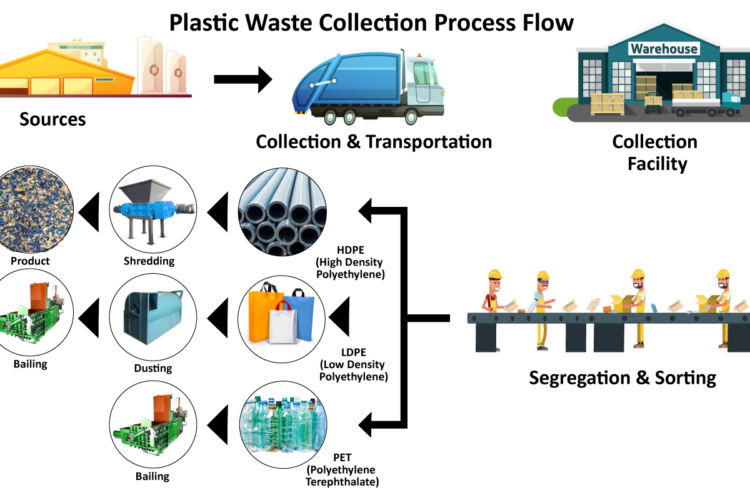In India, Plastic waste is generated in large quantity but is no proper collection facility available. The main sources of plastic waste will be from Industrial Plastic, Scrap Dealers and Municipal Corporations. The Franchisee has to collect the plastic waste from such sources and transport it to their facility. The Plastic Waste generated at the sources need to be collected in proper way chain system. Proper plastic identification should be done for collection and transportation to the site. Daily target of 10 Tons needs to be collected and later may increase the capacity.
Then, collected waste from sources need to be transported to the collection facility. 10-15 tons of vehicle required Own/Rented. It will daily collect 10 Tons of Plastic waste from various sources and transport to the collection facility. Further, Sorting and identification is carried out manually or automatically using appropriate means of identification. The more accurate and efficient the means of identification, sorting and separation, the better is the quality of the recovered product obtained. Best suited for sorting plastics is manual process and we use full time man power for this task. The secondary raw material obtained by hand sorting is of high quality and offers an excellent basis for producing high quality products by small and medium scale industry. To aid in identification, it is now common for plastic containers to have a polymer identification code. Unfortunately, other plastic applications do not carry such identifiers and are, therefore, more difficult to identify by polymer type without some experience. There are several simple tests that can be used to distinguish between the common types of polymers so that they may be separated for processing. We are applying the following test for identification of plastics.
Washing
The scale of cleaning depends on the type of waste. Whenever a cleaning operation is involved, it is to be ensured that the water or any other cleaning material used, should be discharged after ascertaining that the discharge does not contain any objectionable substance. A proper Treatment Device may have to be deployed – like a water treatment plant / effluent treatment plant. For drying, a suitably designed drier is used. Many industries situated outside the metropolises, use open space for natural drying of the cleaned waste. If the plastic is dirty, cleaning is necessary. However, at the moment we don’t have a washing plant to wash the collected plastic and we have planned to establish the washing plant.

Cutting
Cutting is usually carried out for initial size reduction of large plastic objects. It can be carried out with a plastic cutting machine, specifically designed to cut plastic into smaller plastic pieces.
Shredding
Shredding is suitable for smaller pieces. A typical shredder has a series of rotating blades driven by an electric motor, some form of grid for size grading and a collection bin. Materials are fed into the shredder via a hopper which is sited above the blade rotor. The product of shredding is a pile of course irregularly shaped plastic flakes which can then be further processed.
Bailing
Baling is a process that compresses material into a block (bale) which is secured by plastic or wire strapping. The process reduces the volume of the material which:
- Reduces loose waste on site
- Reduces transportation/waste disposal costs
- Turns waste into a revenue generating product
